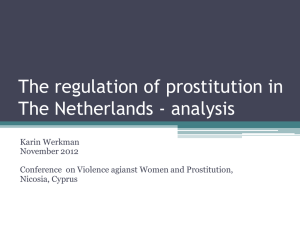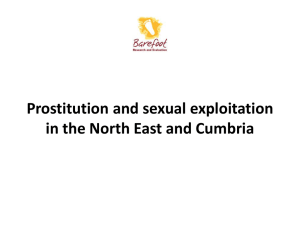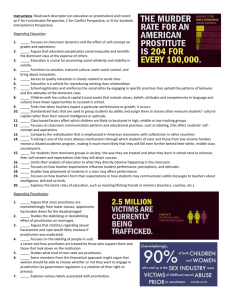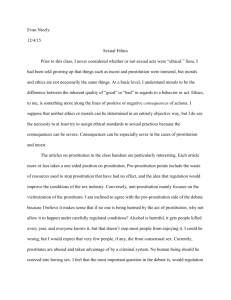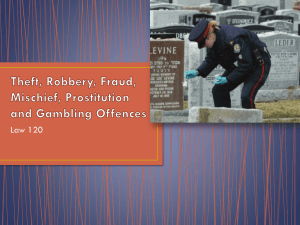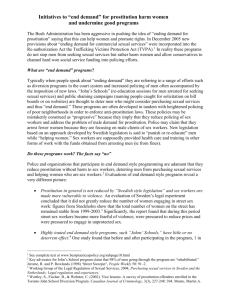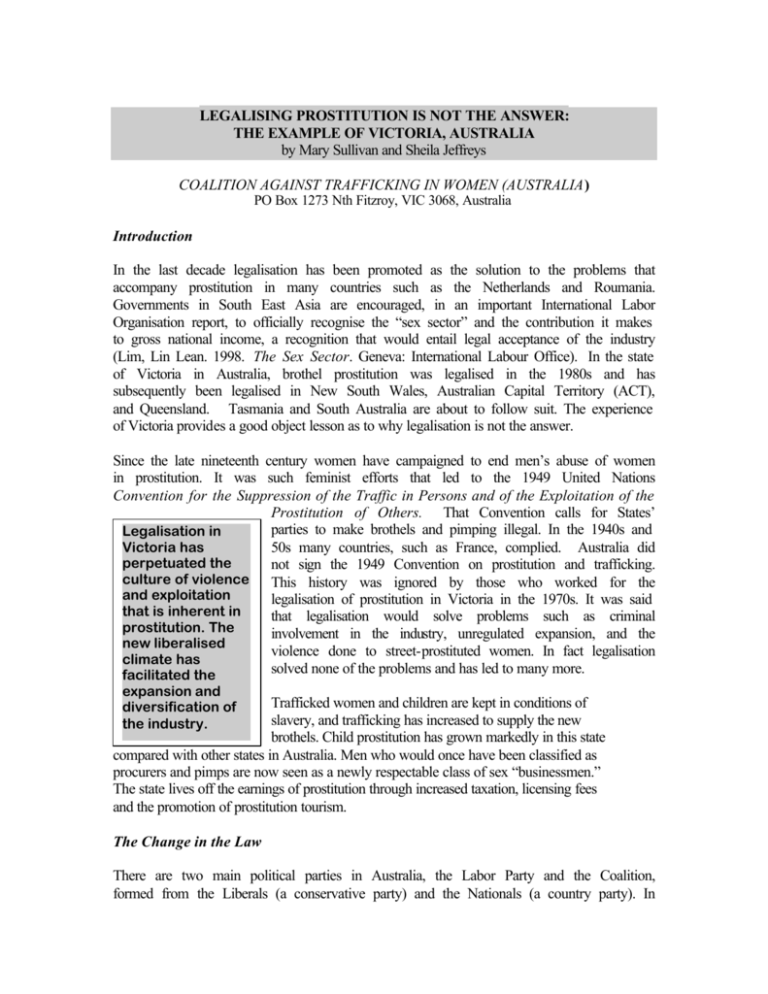
LEGALISING PROSTITUTION IS NOT THE ANSWER:
THE EXAMPLE OF VICTORIA, AUSTRALIA
by Mary Sullivan and Sheila Jeffreys
COALITION AGAINST TRAFFICKING IN WOMEN (AUSTRALIA)
PO Box 1273 Nth Fitzroy, VIC 3068, Australia
Introduction
In the last decade legalisation has been promoted as the solution to the problems that
accompany prostitution in many countries such as the Netherlands and Roumania.
Governments in South East Asia are encouraged, in an important International Labor
Organisation report, to officially recognise the “sex sector” and the contribution it makes
to gross national income, a recognition that would entail legal acceptance of the industry
(Lim, Lin Lean. 1998. The Sex Sector. Geneva: International Labour Office). In the state
of Victoria in Australia, brothel prostitution was legalised in the 1980s and has
subsequently been legalised in New South Wales, Australian Capital Territory (ACT),
and Queensland. Tasmania and South Australia are about to follow suit. The experience
of Victoria provides a good object lesson as to why legalisation is not the answer.
Since the late nineteenth century women have campaigned to end men’s abuse of women
in prostitution. It was such feminist efforts that led to the 1949 United Nations
Convention for the Suppression of the Traffic in Persons and of the Exploitation of the
Prostitution of Others. That Convention calls for States’
parties to make brothels and pimping illegal. In the 1940s and
Legalisation in
Victoria has
50s many countries, such as France, complied. Australia did
perpetuated the
not sign the 1949 Convention on prostitution and trafficking.
culture of violence
This history was ignored by those who worked for the
and exploitation
legalisation of prostitution in Victoria in the 1970s. It was said
that is inherent in
that legalisation would solve problems such as criminal
prostitution. The
involvement in the industry, unregulated expansion, and the
new liberalised
violence done to street-prostituted women. In fact legalisation
climate has
solved none of the problems and has led to many more.
facilitated the
expansion and
diversification of
the industry.
Trafficked women and children are kept in conditions of
slavery, and trafficking has increased to supply the new
brothels. Child prostitution has grown markedly in this state
compared with other states in Australia. Men who would once have been classified as
procurers and pimps are now seen as a newly respectable class of sex “businessmen.”
The state lives off the earnings of prostitution through increased taxation, licensing fees
and the promotion of prostitution tourism.
The Change in the Law
There are two main political parties in Australia, the Labor Party and the Coalition,
formed from the Liberals (a conservative party) and the Nationals (a country party). In
the late 1970s in Victoria, the Coalition government was split over the issue of
legalisation. When a new Labor government was elected in 1982 there was
overwhelming support for the idea. The new government considered that prostitution was
principally an economic exchange. It introduced legislation in 1984 that legalised
prostitution in brothels that obtained a valid planning permit. This approach recognised
brothels as acceptable commercial enterprises that could be viewed as legitimate uses of
land for town planning purposes. To the Labor government, prostitution was seen as a
matter of private sexual behaviour between consenting adults that should not be
criminalised “simply because money changed hands.” A new Coalition government in
1992 continued with the policy, and the new Labor government of 1999 is unlikely to
change it. Legalisation is now embraced by both sides of the political spectrum.
Legalisation in Victoria was not intended to show total approval for the sex industry. The
proclaimed object was what is commonly called “harm minimization.” The prohibition
of prostitution was seen to be ineffective against a highly visible massage parlour trade (a
euphemism for brothels), increasing street prostitution, criminal involvement and drug
use. Legalisation, it was believed, would diminish the health risks, particularly the risk of
sexually transmitted diseases, for either prostituted women or the “clients.” The
appearance of the AIDS epidemic in the mid 1980s was a further stimulus to reform.
Legalisation, however, brought with it new problems.
Ongoing adjustments to legislation became necessary as state
policy makers attempted to deal with a myriad of unforeseen
issues that are not addressed by treating prostitution as
commercial sex—child prostitution, trafficking of women,
the exploitation and abuse of prostituted women by big
business. The harms resulting from the sex industry
constantly change and develop and have to be constantly
readdressed.
As the industry
expands, so does
the variety of ways
in which women
are offered to men
for sexual abuse,
such as tabletop
dancing, and
further
adjustments are
required. No
legislators are
able to foresee the
diverse forms of
sexual exploitation
from which sex
“businessmen”
discover that they
can make money.
The existing model for Victoria’s prostitution law is based on
the Prostitution Control Act 1994. Under the Act, licensed
brothels and escort agencies operate legally, although subject
to local planning controls determined under the Planning and
Environment Act 1997. These controls ensure that sex
establishments are not located close to schools and churches
and other areas frequented by children, ensure their exclusion
from residential areas, and limit the size of brothels to six
rooms. The sex industry is constantly pushing to remove this restriction so that giant
brothels can be created. Brothels may advertise the women who are sold on their
premises to potential customers, but they are not permitted to advertise for workers, a
restriction that the sex businessmen want to change.
The Act also established a Prostitution Control Board composed of lawyers, police and
industry figures in order to ensure “a rigorous licensing procedure for prostitution
services and for the disciplining of licensees.” There is a requirement that prostituted
2
women are registered and must undergo regular health checks for sexually transmitted
diseases and HIV/AIDS.
Most significantly, street prostitution remains a criminal
offence.
By 1997 the Attorney General, Jan Wade, and her supporters were promoting the state’s
prostitution industry as “a highly regulated, profitable, professional and incredibly wellpatronised industry ...that pays taxes.” She saw the legislation as a model for other states.
Expansion and Normalisation of the Industry
Though it was hoped that legalisation would control expansion of the industry, in fact it
has had the opposite effect. Legalisation leads to massive expansion. It would be
surprising if it did not, since this is the very reason that business interests are pushing so
hard for legalisation. An investigative report by Victoria’s Age newspaper in 1999, found
an increase in the number of legal brothels from 40 a decade ago to 94 today, along with
84 escort agencies. Ironically, the real growth area is in the illegal sector. The over 100
unlicensed brothels outnumbered the “legitimate’ sex businesses in 1999 and had trebled
in 12 months” (The Age, 1 March, 1999).
Since the legalisation process began there has been an explosion of forms of sexual
exploitation in the industry. Tabletop dancing, bondage and discipline centres, peep
shows, phone sex and pornography -- all are developing
Each week 60,000
profitably as part of a multi-million dollar industry of
Victorian men spend
sexual exploitation. Tabletop dancing, where women
$7 million on
working as dancers perform nude or semi-nude on tables or
prostitution, with the
podiums whilst men stare into their shaved genitals from a
legalised industry
few inches away, has come under close scrutiny because of
turning over more
phenomenal growth since its inception in 1992. The 1997
than $360 million a
Dixon Report, a government advisory committee evaluation
year and drawing on
some 4500 prostituted of the legalised industry, included tabletop dancing among
its main terms of reference (Prostitution Control Act 1994,
women and girls (The
Age, 28 Feb, 1999).
Advisory Committee Final Report 1997, known as the
When one considers
Dixon Report). The performances include close contact
that Victoria’s
with or touching of men, double acts with other women or
population is around
men (showers, oil wrestling) and personal or lap dances
3.5 million people,
where the dancer sits on a man’s lap “gyrating, twisting and
these figures attest to
generally stimulating his groin area, or rubbing her breasts
how mainstream
in the patron’s face.” Penetration of women with objects
buying the right to
that included mobile telephones being inserted into the
sexually abuse a
woman has become in dancer’s vagina or anus was common. The owner of one of
Melbourne’s most famous tabletop venues, Goldfingers,
the state.
was found guilty, on 10 February 2000 of assaulting and
injuring one of the women from whose sexual exploitation he made his living (The Age,
11 Feb, 2000, p.5).
3
The annual staging of a trade show for the sex industry (SEXPO) illustrates just how
acceptable prostitution is in Victoria currently. SEXPO markets prostitution both locally
and internationally (via the internet) through the promotion of brothels, escort agencies,
tabletop dancing, pornography and other forms of sexually explicit “entertainment” and
“adult products.” Once inside the R–rated exhibition space, crowds attending SEXPO are
surrounded by video pornography and huge screens relaying the stripping that takes place
on the main stage. For example, a woman in a tiny policewoman’s uniform strips, sticks
her plastic gun down her G-string and then offers it to male onlookers to suck. The
stripping was transmitted via the internet around the world, selling Melbourne
internationally as the new sex capital of Australia. On stage, women pretended to orgasm,
while in booths men bought personal lap dances by naked women, having paid between
$A10 to $A35, the price depending on whether a woman retains her G–string or not. The
women are sold for little more than the produce advertised at the frozen yogurt stand next
door. This public event is held at the state-owned Melbourne Exhibition and Convention
Centre (MECC). The Age newspaper devoted the front page of its business section to
SEXPO in 1998 alongside a profile of Australia’s sex industry, said to have an estimated
annual turnover of $A1.2 billion.
So normalised has brothel prostitution become that the sex industry markets itself as
promoting the “rights” of people with disabilities by specifically catering to disabled men
and disability charities. One brothel, “The Pink Palace,” has gained favourable media
attention on radio and in newspapers for putting in even more facilities that cater to this
group of men than the other 15 legal brothels. “The Pink Palace” has spaces for
wheelchairs, specially adapted showers and lower beds. The prostituted women are
specially trained. Some prostituted women, says an article on the brothel, don’t know
“how to lift someone properly, or to handle someone with a catheter. The carer [caretaker
or attendant] of one man with cerebral palsy suggested the sex worker tie up his hands to
avoid being accidentally scratched by him. She didn't and was scratched all over” (The
Age, 14 March, 2001). Disabled men are seen as a good market opportunity by the
legalised sex industry, and carers are expected to help these men engage in the
prostitution abuse of women in brothels, or at least deliver them and wait in the lounge. It
is the “rights” of men that are being catered to here. Disabled women are not mentioned.
Victorian governments (Coalition from 1992-1999, but now Labor once again) profit
from the commodification of Victorian women. 991,000 Australian dollars was raised
from prostitution licences between 1995 and 1998 (The Age, 28 Feb 1999). Already at the
time of the passage of the Prostitution Control Act, 1994, there was evidence that
prostitution was an accepted sideline of the tourism and casino boom. The Labor
Opposition, referring to an Age article entitled “Brothels cash in on casino trade,” brought
to the Parliament's attention the fact that the Government-sponsored casino -- seen as the
financial basis of Agenda 21, a government initiative to revitalise the state’s economy -had authorised the redeeming of casino chips and wheel of fortune bonuses at local
brothels. One Labor opposition member, Jan McClean, spoke against the hypocrisy
surrounding Victoria's prostitution trade, saying that “Our scummy casino chips are
accepted as legal currency in local brothels [and] That apparently is quite acceptable.”
With the Top of the Town brothel claiming a 30 percent boost to its daytime trade,
4
McClean drew the obvious conclusion that “clearly despite condemnation by the Premier
Mr. Kennett, this was ultimately part of Liberal party policy to promote brothels,
especially in the daytime, for the workers.” It was the future implication of this trend that
McClean found deeply disturbing. “The commodification of women would only
intensify” she argued, “as Australia is part of a new wave of world tourism that is made
up of package tours with all services supplied including prostitution.” But the official
position of the new Labor government is to continue the policy of legalisation.
“Sex Work” Empowering for Prostituted Women?
For feminists, one of the most persuasive arguments underpinning legalisation, was that
once prostitution ceased to be a criminal offence, prostituted women would be able to
choose their own working conditions, their “clients,” and, if working for an employer,
would have industry health and safety standards in place. The experience of Victoria
dispels the claim that legalisation empowers women. Large operators dominate the
industry. Former pimps with criminal convictions are forbidden by the prostitution
legislation from owning legal brothels, but they control them under front organisations
(The Age, 1 March, 1999).
This takeover by sex “businessmen” was aggravated by the failure of Victoria’s specialist
prostitution licensing board, the Prostitution Control Board (PCB), effectively to monitor
licensing. Although it was supposedly illegal, multi-ownership exists with incidences of
one proprietor owning as many as six brothels. Licensing procedures will prove even
more inadequate in the future as 1999 saw the PCB replaced by a general Business
Licensing Authority with no specialist knowledge. This is perhaps indicative of just how
far governments in Victoria have moved along the path to seeing the sale and
commodification of women as just like any other business.
The legalisation of brothel prostitution effectively means that women are forced to work
in situations where third parties make profits from offering them for sale. It is almost
impossible for the exploited women to set up in business for themselves. Legal parlours
tend to be expensive, capital intensive buildings, allowing for the monopolisation of the
industry by more wealthy owners. When the 1994 Prostitution Act was passed, brothels
were changing hands for over $A1,000,000.
Some concession was made in the Prostitution Control (Amendment) Act 1997 to allow
for a cottage type industry where one or two women could work in private parlours.
These remain illegal in residential areas and only a handful have been allowed. The only
option for prostituted women to make themselves available to male prostitution abusers
on a small-scale basis, legally, is in industrial backblocks or docklands. This leaves
already vulnerable women open to violence, fear and isolation. Prostituted women also
face exorbitant costs as they are required to disclose their business to landlords, who, in
turn, charge grossly inflated rents. Women’s ability to have any control over their
working environment is, therefore, still extremely restricted. Self-employment would not
solve the problems of prostitution, however, because women would still be available to
men for sexual abuse, albeit without sex capitalists taking so much of the money. But the
5
lack of opportunity for self-employment makes it clear that legalisation was not meant to
be in women's interests.
Women are thus forced to experience exploitation on the streets, illegally, or from sex
“businessmen” in brothels. For women in legal brothels, managers and owners demand
up to 50% to 60% of takings. This is in the face of strong competition among prostituted
women for “clients” as increasing numbers of women enter prostitution, and as men have
an excess of sexual services on offer for them to buy. Legalisation, then, makes it harder
for women to earn a living through prostitution.
Legalisation has not improved the conditions in which prostituted women are sexually
exploited according to Jocelyn Snow of the Prostitutes Collective of Victoria (The Age,
28 Feb, 1999). Her study of the impact of legalisation on the conditions of exploitation
faced by prostituted women found “The worst thing was the clients. The arrogance, the
smelliness, the violence, the demands. One in five clients still request unsafe sex.”
The major area where prostitution law does deal with the conditions of women in legal
brothels is in regulations accompanying the 1994 prostitution legislation. This requires
prostituted women to register and have regular health checkups for sexually transmitted
diseases and HIV/AIDS. The 1988 Report on the First National AIDS Conference
concluded that such a requirement only created barriers to health care for prostituted
women, as they do not wish to identify themselves as “sex workers” and will not access
health services. Moreover, registration bars women from the illegal sector of the trade
from seeking health care.
Such regulation places the blame upon the prostituted women for the spread of sexually
transmitted diseases and, as feminist foresisters pointed out in campaigns against the
Contagious Diseases Acts in the nineteenth century, it leaves the male right to sexually
exploit women unchallenged. This hypocritical double standard was the focus of these
earlier feminist campaigns. The Acts had allowed compulsory examination of women
suspected of prostitution in garrison towns and ports in the UK and Australia. Feminists
argued that they were an abuse of women’s civil liberties, and they were repealed. Today
in Victoria, the state chooses to ignore this historical example.
The Violence of Prostitution
Legalisation promised greater safety to prostituted women. Legalised brothels were
supposed to provide women with protection from the rapes, beatings and murders that are
the hazards of street prostitution. Street prostituted women still suffer extreme violence
on the streets of Victoria. But brothel prostitution is not a solution because, as
spokeswomen from the survivors’ movement such as Evelina Giobbe, Director of the
Commercial Sexual Exploitation Resource Institute and the former Director of
WHISPER, argue, prostitution is violence in and of itself. It is commercial sexual
violence. In the everyday practices of the sex industry, women must engage in acts that
are sexually and physically degrading and are forced to disassociate emotionally by using
drugs or alcohol to survive. The acts that men buy the right to perform on prostituted
6
women include all the forms of sexual violence that feminists are seeking to eliminate
from women’s beds, homes, workplaces, streets.
Sexual harassment at
work cannot be
separated from
prostitution. As
sexual harassment
creates a hostile work
environment for
women, so
prostitution is a
hostile “work”
environment. Men
can buy in brothels
precisely what women
seek to remove from
their workplaces. A
woman student in
Victoria, for instance,
(perhaps one of those
seeking to pay her
way through an
increasingly
expensive and
privatised education
system), is protected
by sexual harassment
policies on university
premises. Male
teachers may not
grab or insult her.
When she crosses the
road to the legal
brothel, the same men
may treat her as they
wish. She has little
redress. The
harassment is what
she is paid for.
The practices that men pay to carry out on women in
prostitution are those that would be illegal if carried out
without such a monetary exchange.
Women seek to
remove sexual harassment from their workplaces, and the
streets they walk in, to stop the practice of obscene phone
calls, which bring male abusers into their homes, and to end
rape. Women in relationships with men seek to end
unwanted sexual intercourse, the practice in which
women’s bodies are used with no respect for the women’s
pleasure or humanity, and replace this with egalitarian
sexual relations which take place only when truly desired.
It is precisely all these forms of sexual violence and abuse,
which arise from women’s historical oppression, that men
can buy the right to carry out on women in prostitution.
Prostituted women, who hate to have unwanted penises and
hands on or in their bodies just as any other women would,
have to endure these abuses to earn a living, buy drugs or a
bed for a night.
In Victoria, at a time when other women are seeking to
desexualise their workplaces assisted by trades unions,
women employed in the sex industry are expected to
endure behaviour not tolerated in other work environments.
Spokespersons for the Prostitutes Collective of Victoria
(PCV) have explained that men are becoming more
demanding in the type of services they want. The demand
for oral sex, for instance, has been replaced by the demand
for anal sex, frequently demonstrated by men simply
sticking their fingers into women’s anuses during their
“bookings.” Other normal practices “include women being
lined up and looked over like any other commodity,” and
sex without condoms. These views are supported by a 1998
study conducted by the Macfarlane Burnett Centre for
Medical Research done in conjunction with the Prostitutes’
Collective Victoria. Forty percent of men in the study did
not use condoms when exploiting prostituted women.
Prostituted women who need money are forced to engage in whatever the customer
requires. The Victorian Health Centre for Transmitted Diseases substantiated that women
who are economically vulnerable often have little choice to refuse services which they
find unacceptable or, from a health aspect, likely to cause diseases such as hepatitis,
chlamydia and genital herpes, let alone AIDS. One young woman student wrote in an
issue of Working Girl/Working Boy of the pain experienced by having men put their penis
7
in her vagina. “I would need to artificially lubricate my vagina because it was dry and
painful,” she says. “Some men would get aggressive, especially if they were drunk.
Somehow I threatened their maleness.” At tabletop dancing venues, a private shower
performance entails a dancer having her naked body lathered by a group of men who
have consumed alcohol. Pauline Burgess, a Women’s Policy Officer evaluating the
working conditions of tabletop dancers, reported that the experience was so disturbing
that women were moving into the area of peep shows to prevent personal contact with the
men who abused them.
Once prostitution is legitimised as an acceptable commercial practice, few ethical barriers
exist to prevent newly brutal forms of exploitation. The sex industry was quick to
recognise that, along with a woman’s vagina and anus, all of her reproductive capacities
are sellable products. The magazine of the Prostitutes’ Collective of Victoria, in a 1999
piece entitled “The Working Mother to Be,” highlighted the benefits that could accrue to
women from working whilst pregnant. As the writer states “pregnant women may find
themselves with a whole new group of clients who find pregnancy a turn on.” In addition,
if offered the service, “a surprising number of men find drinking breast milk either
arousing or soothing.”
The standard act of prostitution, coitus, is experienced as so violating by prostituted
women in the legal brothels that they have to dissociate emotionally and engage in
complex diversionary tactics to restrict the degree of harm they suffer. One woman
explained to CATW Australia the way she survived. Like other women she cut off
emotionally long before she got to work, getting the children out of the way, stopping
incoming phone calls, and making the transition to the dissociated person who would be
able to endure the men’s demands. She had a prostitution name and personality separate
from her “real” self. “Clients” would lie on a table for a massage. As she massaged their
backs they would try to grab her breasts and she would move further away, all the time
trying to distract them by her verbal wit so that they did not demand to penetrate her too
soon. Usually she could restrict the most violating act to the last 5 minutes of a 30 minute
booking. Trafficked women and those with less verbal agility would have to endure the
most violating activities for longer. The effects of such dissociation on women are
damaging to their emotions and sexuality.
Those who defend prostitution and call for legalisation often say that it is consensual and
women “choose” this “work.” What does this “consent” consist of? Many women engage
in two forms of work to make enough money to survive. One third of prostituted women
working in brothels in Victoria earned less than 500 Australian dollars, with only one in
five earning more than $1,000 per week (The Age, 28 Feb, 1999). Thus a woman who
waits tables in the daytime, protected perhaps by a sexual harassment policy, against men
grabbing her breasts, will be considered to have “consented” at 5 p.m. to much more
violating acts in the licensed brothel. In fact the “consent” is likely to take the form
simply of dissociation.
The tens of thousands of men who use women in the sex industry in the State of Victoria
are expected to understand that women in prostitution are suitable objects for their
8
unwanted remarks, hands and penises, whilst their female workmates in factories and
offices are not. Of course, many will fail to understand this distinction. If it is acceptable
to insult, grab, abuse and harass a woman in one place just because a man has paid for it,
why should it shock a woman in another place to have the same treatment? Also, what
you can buy you can also steal.
Street Prostitution
Legalisation was supposed to get prostituted women off the streets. Street prostitution
remained illegal. It was thought that women would choose to work in brothels. In fact
street prostitution still exists because it is related to wider social problems. Women who
are homeless, seriously drug addicted, under age, or who want to avoid being exploited
by sex “businessmen” continue to work on the street and suffer severe violence there.
The government’s Advisory Committee on prostitution determined that women are the
vast majority of street prostitutes, though there are also boys and transsexuals. Women
remain in the industry for between 10–15 years, “entrenched in a life cycle of
prostitution, drugs and prison.” A Victorian study called Off Our Backs in 1996
confirmed that 80 percent of street prostituted women are heavy drug users, with a
$A100–500 a day drug problem. Forty–six percent are mothers with children in
protective care.
Street prostituted women, because of the illicit nature of their work, are doubly
vulnerable to rape, battery and murder from the men who use them and from male passers
by. Statistics produced by the Prostitutes’ Collective of Victoria prior to the passing of
the 1994 Act reveal that reported rapes of prostituted women averaged 2 per week, with
one assault per night and 2 murders over the last year. Street prostituted women are
harassed by police and gutter crawlers. However, when prostituted women are
criminalised they cannot demand police protection or claim legal recourse for robbery or
coercion, for they thereby expose themselves as implicated in a criminalised trade.
Street prostitution was very much in the news in early 2001. Residents in the main
prostitution area, St Kilda, demanded action from the state government because the
prostituted women are being abused in the porches and gardens of the St. Kilda residents.
A residents’ spokeswoman stated that there is now “an open-air, uncontrolled,
unmanaged, all-day brothel” (The Age, 24 Feb, 2001). A study by the Sacred Heart
Mission, which surveyed 65 women in the area with whom it had contact in one month,
found 35 were prostituted (Gay Mitchell, From Exclusion to Connectedness, Sacred
Heart Mission, Melbourne, 2001). Of these, all had been sexually abused as children.
They were all either living in an abusive relationship or had suffered domestic violence.
All were homeless or in unstable housing. None had ever worked other than in
prostitution. All had left school early. All had been removed from home as children or
had other contact with child welfare agencies. Of 15 whose mental state was known, 13
had been diagnosed as mentally ill. Twenty-two were current or former heroin users. The
problems of street prostitution cannot be resolved by the legalising or deregulating of
brothels. It seems that the more profitable and normalised the sex industry is, as in
9
Victoria, the more out of control sexual exploitation of the most vulnerable women and
children on the street is likely to be.
The Rise of a Black Market
Legalisation was intended to eliminate organised crime from the sex industry. In fact the
reverse has happened. Legalisation has brought with it an explosion in the trafficking of
women into prostitution by organized crime. Convicted criminals, fronted by supposedly
more reputable people, remain in the business. Fred Lelah who ran Sasha’s International,
one of Melbourne’s inner suburban legal brothels, appeared before the Melbourne
Magistrate’s court in February 2000 for introducing girls 10-15 into his business. Lelah
has already served a two year term for the same offence.
Recently it has been revealed that Victorian sex “businessmen” are involved in the
lucrative international sex trade run by crime syndicates which is worth $A30 million in
Australia. An Australian Institute of Criminology study estimated that Australian brothels
earned $1 million a week from this illegal trade. Some examples of the trade came to
light in 1999. One Melbourne sex trafficker brought 40 Thai women into Victoria as
“contract workers,” depriving them of their passports and earnings until their contracts
were worked off. This is called debt bondage. The women had to have sex with 500 men
before receiving any money and were imprisoned by him (The Age, 9 May 1999). This
man has since received an 18 month suspended sentence and a fine, to the outrage of
those who want the traffic of women into sex slavery taken seriously. In another case 25
Asian women were found in similar circumstances in one of Melbourne's legal brothels.
These incidences are likely to be but the tip of the iceberg, and The Age newspaper states
that a number of legal brothels are known to contain such “contract workers.”
The commercial sexual exploitation of young people in
Metropolitan Melbourne is also rife. ECPAT (End Child
Prostitution and Trafficking) conducted research in 1998
for the Australian National Inquiry on Child Prostitution by
asking youth and community agencies in Melbourne how
many young people that had used their services had been
used in prostitution. The figure was 1 in 7. In a study
conducted by the Victorian Department of human services,
young people involved in commercial sexual activities
reported having “significant” contact with child sexual
abuse (“paedophile”) rings. These young people disclosed
that as a consequence of their involvement with
“paedophile” rings, they experienced rape and were forced into pornography
Of all the states and
territories, the highest
number of reported
incidences of children
involved in
prostitution came
from Victoria. There
was also clear
evidence of organised
commercial
exploitation of
children.
Feminist campaigners who worked through the League of Nations against the traffic in
women between the World Wars I and II argued that licensed brothels acted as
warehouses for trafficked women (Jeffreys, Sheila, 1997. The Idea of Prostitution.
Melbourne: Spinifex). Currently these brothels create a demand for constant new recruits,
and fuel the illegal trafficking industry. The U.S. State Department’s Human Rights
10
Report for 1999 criticises Australia for lax laws on prostitution, including legalisation,
which make it difficult to act against trafficking. It is not possible to tackle the trafficking
in women with any seriousness until brothels are abolished.
Effect of Legalised Prostitution on the Status of Women
Women have described to the Melbourne Coalition
Against Trafficking in Women (CATW) how their
marriages of 20 years and more have been destroyed by
their husbands’ abuse of women in prostitution. One
woman sought help from a priest after years of seeing
the family finances ruined by her husband’s behaviour.
But she had to end the marriage. Legalisation allows
men to feel more justified and confident in their
prostitution behaviour. Meanwhile women’s desire to
have egalitarian relationships with men in which they
are respected becomes more and more impossible to
fulfill. As the industry grows, more and more women
are finding that they have the choice to accept the way
their male partners treat other women, to avoid
recognising what their partners are doing, or to leave.
As the sex industry
expands it has a greater
destructive effect on
women’s relationships
with men. A Melbourne
brothel owner explains
the client base of her
business thus: “Those
men who used the
prostitutes were well
educated professional
men, who visit during the
day and then go home to
their families. Most of
[the] clients,” she
concluded, “have secure
marriages and have no
intention of leaving their
wives.”
Prostitution is an industry that arises from women’s low
social status and the relegation of women to the role of
sex objects. Legalising prostitution maintains that low
status and makes it much harder for women to assert that they should be treated with
dignity and respect.
Whilst women in this state strive to improve their status, the sex industry provides a
constantly expanding obstacle. Women have sought to gain equality in employment
opportunities in corporations, for instance. This is seriously undermined by corporate use
of facilities, such as tabletop clubs, for meetings and entertaining corporate clients. These
clubs market themselves as places where companies can hire rooms with whiteboards to
write on for product launches and meetings. Club owners supply naked women on the
table at teabreaks and at lunchtime. Women executives are not likely to attend such
meetings. The tabletop venues operate and often describe themselves as “gentlemen’s
clubs.” Whereas once women sought to challenge the power and privilege men gained
from men-only facilities, and gained right of entry to many, the new men’s facilities
created through the sex industry create a whole new culture of men-only bonding. In the
new “gentlemen’s clubs,” men bond through the collective abuse of women.
Advertisements for these clubs, offering women to men as objects for sexual use, span
major roads in Melbourne educating new generations of men and boys to treat women as
subordinates.
11
A generation of men in Victoria have now learned that it is acceptable to treat
women as objects for their sexual use.
Victoria as a Model for Legalisation
Considering that legalisation of prostitution in Victoria has created so many problems, it
is alarming that it is being held up as a model of the way to go. In New South Wales
(NSW), brothels were decriminalised in 1995. Control of illegal prostitution was taken
out of the hands of the police, to end endemic police corruption, and placed in the hands
of local councils and planning regulations. The councils have neither money nor
personnel to put private investigators into brothels who can seek to prosecute those
operating illegally. Brothel owners are now calling for Victorian style controls because
the industry is expanding so fast and with so little regulation that there is much less profit
available. Brothel numbers had tripled by mid 1999 to 400-500 in Sydney. The vast
majority had no licenses but operated and advertised anyway. Pillars of society, such as a
one-time investment adviser to the media baron Kerry Packer, were allowing their
premises to be used for brothels in the hope of gaining some of the profits to be made.
According to a report on the out-of-control industry by the Sydney Morning Herald,
hundreds of brothels specialising in Asian women are being set up, creating a huge
industry out of the traffic in women (Sydney Morning Herald, 30 August, 1999, 31
August 1999).
Conclusion
Opposition to men’s prostitution abuse, and challenging the social acceptance of the
prostitution industry, is aided in many countries by the existence of a prostitution
survivors’ movement that speaks out about what prostitution really means for women. It
was the speaking out of survivors that empowered the feminist challenges to other forms
of violence: domestic violence, rape, child sexual abuse. In a country ilke Australia, and a
state like Victoria, where prostitution abuse has been so normalised, it is particularly hard
for survivors to speak out against it. One resource run by and for prostitution survivors
does exist -- Linda’s House of Hope, in Perth, West Australia (see Linda’s House of
Hope, Compass, ABC TV, 29 April, 2001). As the prostitution survivors’ movement
develops, it will be easier to change the climate of acceptance that has allowed the
industry to flourish in Victoria and elsewhere, and gain an effective solution to the
problems of prostitution outlined here.
The reality is that prostitution cannot be made respectable. Legalisation does not make it
so. Prostitution is an industry that arises from the historical subordination of women and
the historical right of men to buy and exchange women simply as objects for sexual use.
It thrives on poverty, drug abuse, the trafficking in vulnerable women and children.
Prostitution teaches men how to mistreat women and damages the lives of both the
women who are used, the women whose partners, sons, brothers and workmates are the
abusers, and the status of all women in the state. Legalisation causes the business of
12
sexual exploitation to flourish. As more and more women and children are drawn into the
industry, and more and more men become abusers, the profits from the abuse become an
indispensable part of the state’s revenue. The sex “businessmen” network with judges
and politicians, and float their brothels on the stock exchange. Once prostitution is
legalised, ending it becomes much more difficult, as a lobby of “respectable”
businessmen would have to be put out of business, and the government would have to tax
the rich instead of living off women’s bodies.
Ultimately the best way forward in Victoria would be to follow the example of Sweden
where model legislation in 1998 penalises the men who “buy sexual services” and
decriminalises the women. In combination with generous services to support prostituted
women in getting out, this would be effective. Unfortunately it will take some time to
create a social understanding of prostitution in Victoria that will make this possible.
Countries that have not yet gone down the path of legalisation are in a position to develop
policies to end the harms of prostitution. Legalisation compounds the harms of
prostitution rather than relieving them. It is not the answer.
13


